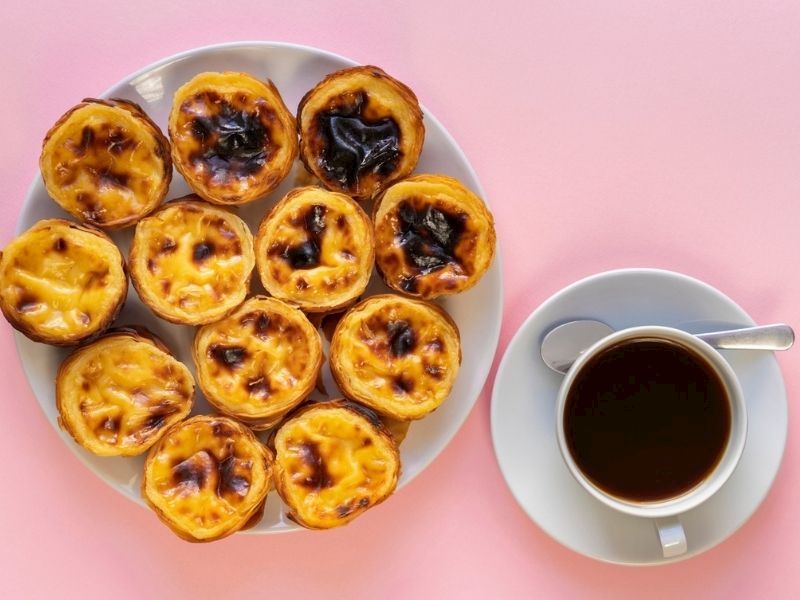The Portuguese Custard - Pastel de Nata

Pastel de nata, also known as Portuguese custard tart, is a traditional Portuguese pastry that has a rich history dating back to the 18th century. The story of pastel de nata is closely associated with the Jerónimos Monastery in the Belém district of Lisbon, Portugal.

The creation of pastel de nata is credited to the Catholic monks of the Jerónimos Monastery. In the early 18th century, many monasteries and convents in Portugal used egg whites to starch clothes, leaving them with a surplus of egg yolks. Seeking a way to avoid waste, the monks and nuns began incorporating the excess egg yolks into their culinary creations.

The monks at the Jerónimos Monastery developed a delicious custard tart filled with a creamy egg custard encased in layers of crispy, flaky pastry. The recipe was a well-guarded secret within the monastery for many years. However, with the liberalization of the economy in the 19th century and the subsequent closure of many monasteries and convents, including Jerónimos, the recipe for pastel de nata was at risk of being lost.
In 1837, the monks of Jerónimos Monastery sold the recipe to a nearby sugar refinery called Antiga Confeitaria de Belém. The refinery's owners, who were likely regular customers of the monastery, started producing the custard tarts using the original recipe. The pastries quickly gained popularity, and the bakery, now known as Pastéis de Belém, still operates today, drawing visitors from around the world.
While Pastéis de Belém remains a popular destination to enjoy pastel de nata, the recipe has spread to many other bakeries and homes throughout Portugal and beyond. Pastel de nata has become an iconic Portuguese dessert, loved for its delicate balance of flaky crust and creamy custard filling, often sprinkled with a touch of cinnamon or powdered sugar. It has also gained international acclaim, with people worldwide savoring the deliciousness of this classic pastry.
Pastel de Nata Recipe;
Ingredients:
For the pastry:
- 1 sheet of puff pastry (store-bought or homemade)
- Flour (for dusting)
For the custard filling:
- 2 cups whole milk
- 1 cinnamon stick
- 1 strip of lemon peel (use a vegetable peeler)
- 1 cup granulated sugar
- 3 tablespoons all-purpose flour
- 3 tablespoons cornstarch
- 6 large egg yolks
- 1 teaspoon vanilla extract
For serving:
- Powdered sugar
- Ground cinnamon
Instructions:
1. Preparing the pastry:
- Preheat your oven to 400°F (200°C).
- Roll out the puff pastry on a lightly floured surface until it's a thin sheet.
- Cut the pastry into squares or circles, depending on your preference.
- Line greased muffin tins or tart pans with the pastry, pressing it gently into the molds. Ensure the pastry covers the base and sides of each mold.
- Prick the bottom of the pastry with a fork to prevent it from puffing too much during baking.
2. Making the custard:
- In a saucepan, heat the milk with the cinnamon stick and lemon peel over medium heat. Once it starts to simmer, remove it from heat, cover, and let it steep for about 15-20 minutes to infuse the flavors.
- In a separate bowl, whisk together the sugar, flour, and cornstarch.
- Remove the cinnamon stick and lemon peel from the milk and reheat it until it's warm.
- Gradually whisk the warm milk into the sugar and flour mixture until smooth.
- Return the mixture to the saucepan and cook over medium heat, stirring constantly until it thickens.
- In a separate bowl, beat the egg yolks. Gradually whisk a small amount of the hot milk mixture into the beaten yolks to temper them.
- Pour the tempered yolks back into the saucepan, whisking constantly.
- Continue to cook the custard until it thickens to a pudding-like consistency.
- Remove from heat, stir in the vanilla extract, and let the custard cool slightly.
3. Assembling and baking:
- Preheat your oven to 475°F (245°C).
- Fill each pastry-lined mold with the custard.
- Bake the pastries in the preheated oven for about 10-15 minutes or until the pastry is golden brown, and the custard has set.
- Keep an eye on them, as baking times can vary based on your oven.
4. Serving:
- Allow the pastries to cool slightly before removing them from the molds.
- Dust with powdered sugar and ground cinnamon before serving.
Enjoy your homemade pastel de nata! These delightful custard tarts are best when served warm.
I share some Pastel de Nata recipe videos below;
How to Make Pastéis de Nata;
Belem Turtası | Pastel De Nata ;
Learn How to Make Pastéis de Nata ;
Belem Turtası (Pastel de Nata) Tarifi;
Pastéis de Nata recipe;
References;
- Julian Baggini (18 February 2015). "Custard tart fight: can the British version ever compete with Portugal's pastéis de nata?". The Guardian.
- "3 KUDAPAN KHAS JAKARTA HASIL AKULTURASI BUDAYA". infobudaya.net (in Indonesian). 2017-09-18.
- Santos, Nina (26 February 2017). "A Brief Introduction to Pastel De Nata, Portuguese Custard Tarts". Culture Trip. Retrieved November 12, 2019.
- "175 anos de pastéis de Belém [175 years of pasteléis de Belém]". Correio da Manhã (in Portuguese). 12 August 2012. Retrieved June 6, 2018.
- "Jeronimos Monastery, Lisbon". www.golisbon.com.
- "Pastéis de Belém: A Taste of History". May 27, 2016.
- Fox, Killian (13 September 2009). "The 50 best things to eat in the world, and where to eat them (The Guardian)". London.
- Pastel de Nata wetravelportugal.com. Retrieved 9 July 2022.
- Swinnerton, Robbie (5 September 2009). "Take a little bite of Portugal's egg tart". Japan Times.
- Costa e Silva, Susanna; Elo, Maria (30 November 2017). "How to Internationalize a Traditional Portuguese-Style Food--Liability or Asset of Portugueseness?". In Verbeke, Alain; Puck, Jonas; van Tulder, Rob (eds.). Distance in International Business: Concept, Cost and Value. pp. 425–44. ISBN 9781787437180.
Thank you for reading my article!
You can complete great comment tasks with commenting. #portuguese #cuisines #pasteldenata #bakery #foodinspiration #food







































